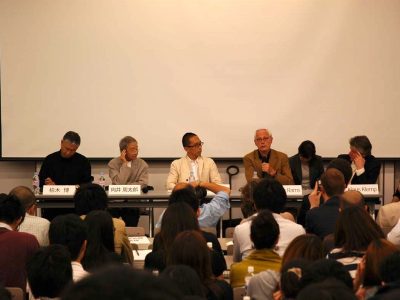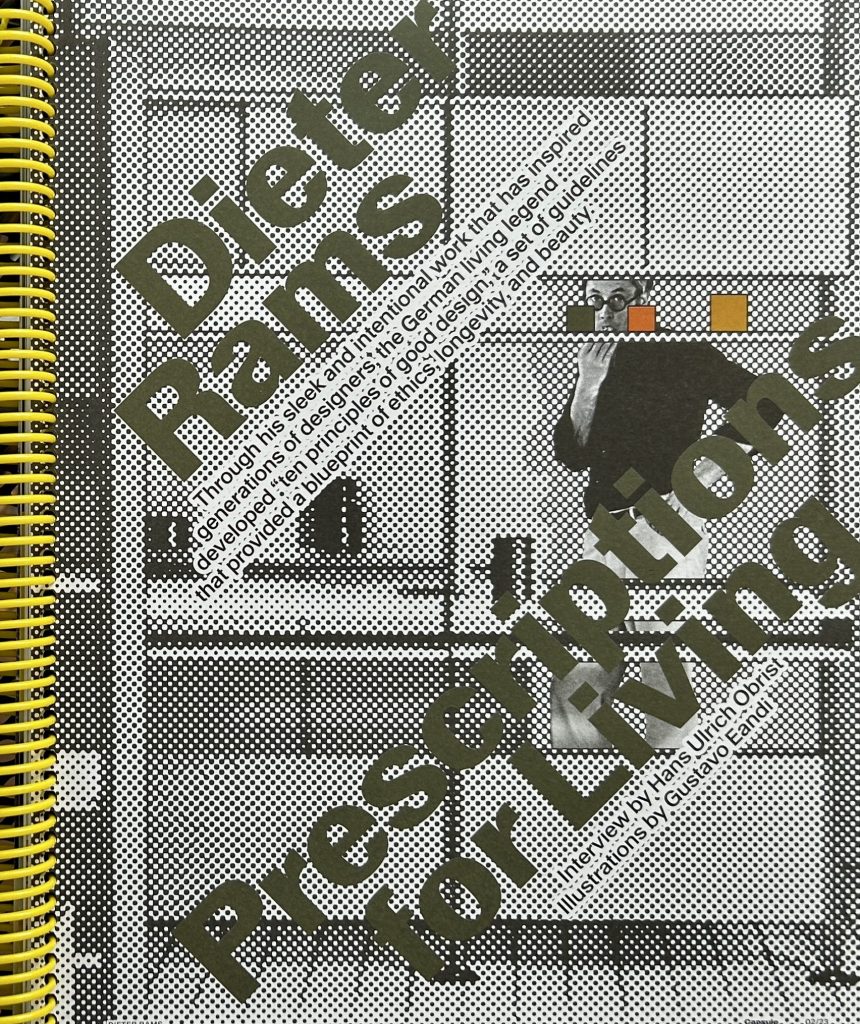
Illustration of the interview in the magazine Capsule April 2023
© Capsule Magazine, Milan
“Epiphanies happen only occasionally”
Interview by Hans Ulrich Obrist with Dieter Rams
Hans Ulrich Obrist (HUO): Dieter, you studied architecture, not design, and you have pointed out that some of the best designers were trained as architects. Why are architects such good designers? Can you describe how you transitioned from architecture to product design?
Dieter Rams (DR): Architecture and product design have similarities. They both involve choosing materials, judging proportions, introducing color, and, not least, they are about functionality. However, architecture and product design also involve emotional approaches, symbolism, meaning. The professions overlap. The architect Hans Soeder, who was the director and reformer of the Werkkunstschule in Wiesbaden, at which I completed a degree as an architect and interior designer, called his course “Design for Spaces and Devices.” So, there was a close connection between the two in my studies. For a long time, there was no training for product designers in Italy, which is why it was mostly architects who dealt with products. It wasn’t much different in Germany through the 1950s.
DR: I didn’t really learn anything from the Ulm School of Design. I already had my Wiesbaden background, which — due to the architect Hans Soeder — was also based on 1920s modernism. He was a member of the architectural collective “The Ring,” to which Walter Gropius, Hugo Häring, Hans Scharoun, Adolf Meyer, Ernst May, the Luckhardt brothers, Bruno Taut, and Ludwig Mies van der Rohe also belonged. In my opinion there was no new ethics of design in the early postwar period in Germany. The voluptuous forms and decorative elements of the “Gelsenkirchen Baroque” style were still in effect, not only for furniture but also for radios. For me, the 1950s aesthetics of kidney-shaped tables with thin legs and lamps with bell-shaped shades did not represent progress at all; they were kitsch. Craftsmanship was quite important for me, as I had done an apprenticeship as a carpenter. There is no question that the Ulm School of Design went in new directions, but so did the Folkwangschule in Essen and many other schools such as the one in Wiesbaden. When I was a student, we went on excursions to the first German showroom of Knoll international in Stuttgart, and what I saw there really impressed me. However, I was more interested in architecture. The two years that I spent in Otto Apel’s architecture firm in Frankfurt, which later became ABB, were very important to me, as was the office’s contact to Skidmore, Owings, and Merrill in Chicago. It was a bit of a coincidence that I started working for Braun, first as an architect; after six months, they also asked me to work on some product design, because they wanted to develop an internal design department that was to work closely with the technicians. As so often is the case, it was a stroke of luck. Since I had permission from Erwin Braun to work independently, I was also able to work as a freelance furniture designer. That is how the company Vitsœ came about, first with Otto Zapf, then with Niels Wiese Vitsøe, and later in Great Britain with Mark Adams, who is still in charge. I am, of course, very proud that my 606 Universal Shelving System and my 620 Chair Program are still being produced and distributed all over the world.
DR: Alas, epiphanies happen only occasionally. My ten principles are the quintessence of my own design practice — not a manifesto, but intentionally chosen principles that should be considered and discussed. As a thinking designer I have always reflected on what we do as designers. We certainly can’t save the world, but we can contribute to it becoming a better place. When I began working, Germany was marked by the physical and spiritual destruction of the Nazi era, which I was initially focused on cleaning up. My experience of the destruction and chaos of this gruesome war as a child and teenager turned me into an avowed pacifist, which I still am to this day. My ten principles were originally part of an internal project at Braun, defining our approach to design. I expanded them over the years to include ten principles instead of six, since from the very beginning environmental soundness was important. Since around 1970, anyone who could read has been familiar with the warnings of the Club of Rome. A long product cycle is in my opinion an effective means of limiting pointless, rapid overconsumption. Not only should the technology of the products be long-lasting and repairable, the appearance should also be enduring. Good design can provide that. In addition to my ten principles, you should also read my explanations. Many designers have, without doubt, referenced these principles. Jony Ive has mentioned them in many interviews, as well as Jasper Morrison and Naoto Fukasawa. They carefully examined Braun products, learned from them, and developed their own approach. They didn’t simply adapt the designs; they expanded on them in an intelligent way. My students in Hamburg were receptive of them, too, and I think that especially today there is renewed interest. I am always happy about new approaches. On the other hand, there are articles in the papers I read in which design is viewed as a sandbox game. That a once-serious design journal such as form is now publishing antiprinciples entitled “Grilling Rams” and supporting dysfunctional, resistant design is scandalous and does little to further the discussion about the future.
DR: When I was head of design at Braun, our motto was that new design can only happen in connection with new technology and functionality. The food processor KM3 has been produced practically the same way for decades. The lemon press that I designed with Jürgen Greubel is still produced by De’ Longhi and will celebrate its fiftieth anniversary this year. The same applied to camera flashes, which prevented owners of older devices from being prematurely motivated to buy a new model — because theirs looked exactly like the new one, even if the new one may have been slightly more efficient. That approach was the exact opposite of American marketing, producing a new car model practically every year that hardly differed from its predecessor in terms of technology. In the 1990s, the American marketing firm of Gillette’s parent company won out at Braun and began constantly pushing for new designs. I always strove to use the Braun logo in the most unobtrusive way possible. Even in the early portable radios, I made it smaller several times. The logo is so good that it doesn’t have to proclaim: “I am a Braun!” A small logo is much more powerful than a large one, and the logo is quite unobtrusive on my stereo units of the 1960s to 1980s. It was possible to identify Braun devices merely due to their exterior design. Of course, this led to many a heated discussion with the marketing department and, in the 1990s, with the American director. I could only repeat Peter Behrens’s old realization that “less is more” in terms of products.
DR: In the statement that I published on my 90th birthday, I said, “We must engage in fewer things, and specifically in ones that are more useful, more environmentally friendly, more universal, and more fascinating. In my opinion, that is the key to transforming mindless consumerism to responsible consumerism. Attractivity must be related to new, convincing concepts and functions, not to the pretty appearance designed as a superfluous incentive to buy.” Of course, ethically justifiable design should also be an issue for managers, because it is not the designer alone who decides about what is produced and what not. While business students learn a lot about marketing, they are not taught is the tenants of good design. That means that in addition to profit and growth, corporate goals should focus on the meaningfulness of their products. Design should really be a mandatory course for anyone studying business.
HUO: There is a lack of long-term thought in our systems, our politics, and our popular culture, which is intensified by the limited lifespan of digital culture and social media. How does our present relationship to the future compare with the time in which you grew up? You have also said, “There is no future with so many superfluous things.” How should we approach design for the future?
DR: First, I do not think that everything used to be better, which is something that a lot of old people say. They were saying similar things in ancient Greece in the age of Aristoteles. My generation’s only hope for a better future was due to the recent period of war and the disaster the Nazis had left behind. We had to straighten things up, not only physically, but also spiritually way. For us, better design — as opposed to design that aimed for prestige or was sentimentally ornate — represented liberation from the weight of the past. The 60s were a time of incredible upheaval and awakening. Of course, it was also the beginning of constantly increasing consumerism. Our reaction to this was designing sensible products, with longevity and practicality. The situation today greatly troubles me. While the climate catastrophe can no longer be denied, cars are getting larger and larger, and we are consuming more instead of less. Putin is conducting a bloody confrontational war against Ukraine, and the United States and China have gone from economic cooperation to political confrontation. I am sometimes very skeptical of the future.
HUO: Do you use the internet and/or social media? How do you feel about digital culture and design?
DR: I don’t use either. It’s all very suspicious to me, and I don’t want to sit in front of the computer for hours. I prefer tending to my bonsai garden and thinking on my own. This includes close reading of books and newspapers. The old media still functions quite well in my opinion — and, in some ways, even better. Nevertheless, digitality is certainly quite important nowadays. Models can be produced much more quickly than they used to be, although speedy renderings also result in designs that have not been thought completely through because everything looks so good at first glance. Designers should always think first about whether their designs really represent progress. Design begins in our heads, not in computers. Bringing our first ideas to paper by hand is, in my opinion, still a valid process.
August 2022
First published in Capsule Magazine, Milan, April 2023
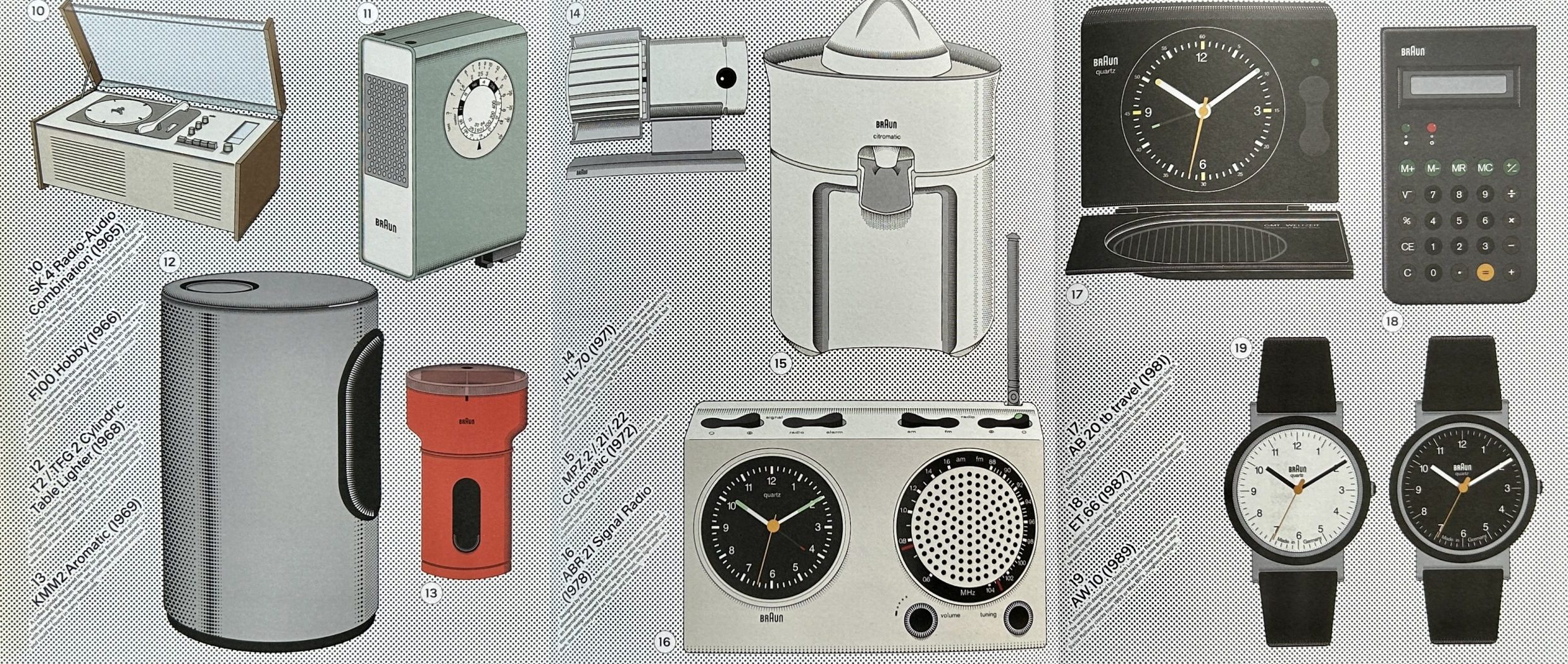
HUO: You and your wife Ingeborg started the Dieter and Ingeborg Rams Foundation to promote responsible designing for the next generation in 1992. The foundation collaborates with the Museum of Applied Arts in Frankfurt, where you are putting together your personal archive. Could you tell me more about the archive aspect of the foundation?
DR: The idea of having a scholarly archive came about in connection with research that curator Klaus Klemp was doing for the exhibition “Less and More” in Japan in 2008. Klemp was the design curator for the permanent collection and special exhibitions at the Museum of Applied Arts in Frankfurt at the time, and he is still the director of the archive. In 2009, we began our cooperation with the museum, which provided us with a suitable space, although the archive is still the property of the foundation. It consists of texts, speeches, interviews, correspondence, films, and photographs, which were systematically expanded using material from my premature legacy and other sources. Today the foundation has two employees who are occupied with digitizing the over seven thousand photographs and organizing, systematizing, and categorizing the numerous documents. Since there are also sources on the drafting process, the implementation strategies in the company, the reception, and the contemporary design discussions, the archive is not only about my work; it also gives insight into the larger connections. At the moment, scholars can only be admitted on a limited basis, but this will be expanded in the future. A website is also being developed. This type of archive is, of course, never finished, but it has almost reached the point where users can use it. The museum in Frankfurt has a considerable permanent loan of Braun products that includes around 700 drafts and presentation models. That ideally complements the archive and is also ideal for a future research activity. A conservation campaign that covered all the models was just completed. The museum will eventually show my works in a special exhibition area, which will be presented in new thematic exhibitions based on works in storage. The archive is in a good place with Richard Meier’s beautiful architecture, which I greatly admire.
HUO: I have heard that you recently restructured the foundation and that the new board includes the architect Till Schneider. Can you tell me about this restructuring and about who else is involved?
DR: It took us a long time to raise the foundation capital. At the beginning of this year, my wife and I decided, however, to transfer a large part of our private assets to the foundation to make it more professional and empowered. In addition, we have Klaus Klemp as the managing director and a board that is still to come. One of the board members is the Frankfurt architect Till Schneider. I will appoint other members of the board. Together we are going to plan the long-term direction in the coming months and discuss possible new areas of action. My ten principles of design will certainly play a role there. Unfortunately, my wife passed away this year in May, so she did not live to see the restructured foundation. Last year, the foundation already organized a traveling exhibition that is entitled “Dieter Rams: A Look Back and Ahead”, which explores what long-lived design can be, using the example of my work. Of course, it is historical, but it is particularly aimed to show these design principles to young people and stimulate them to think. After being shown here in Frankfurt, the show traveled to two venues in the United States, and we are working on organizing other international tours.
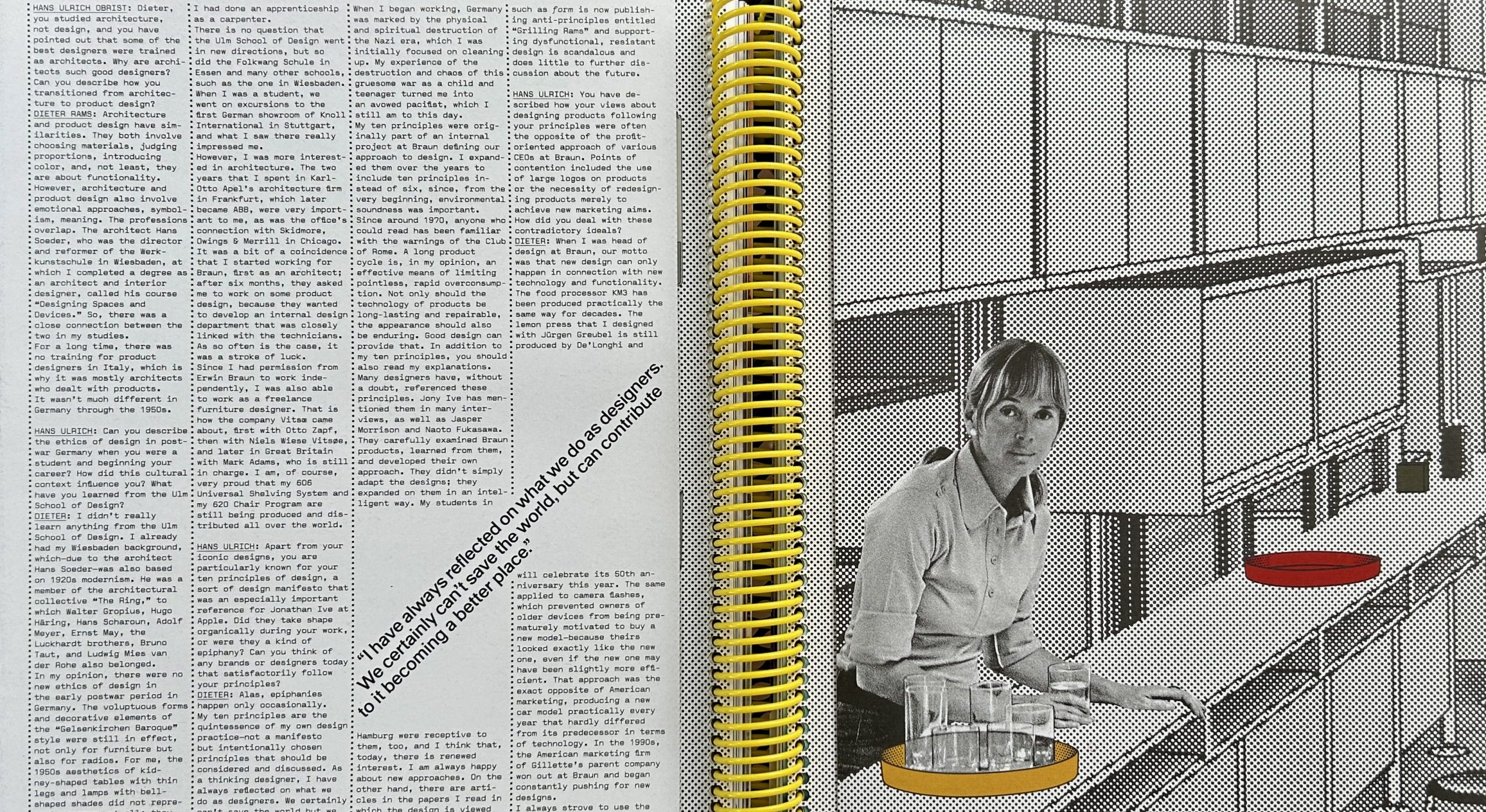
HUO: You have said that if you could travel back in time and do everything all over again, you would not choose the same profession. You have also said that you would have rather been a landscape architect. Can you comment on that?
DR: I would be a landscape architect or urban planner. The world’s problems are so large today that it is no longer only about the realms of objects for personal use. That’s still the focus — it is not my intention to deny that. Just think about all the garbage in the world, which is created by mindless product design. If I were young and had to choose a profession, I would be interested in doing something with megastructures. That is a broad area of research and design.
HUO: You have said, “We need new landscapes along with new cities. We need new structures for our behavior patterns.” You have also said that “the unspectacular things are the most important things, particularly in the future.” Can you give me several examples of these new structures, cities, systems, and unspectacular things that need to be designed? How would you approach them?
DR: Now, you can’t expect me to have a master plan ready for the material design of a better world. I don’t have one, and it would be presumptuous to claim that I did. However, I do think that many principles of my approach to design could be transferred to larger systems: careful use of resources, usability, comprehensibility, longevity, attention to detail, aesthetics (or beauty), and, finally, as little unnecessary design as possible.
HUO: You have been talking about redesigning systems since the beginning of your career, perhaps most iconically with your 606 Universal Shelving System for Vitsœ. You have said, “A system is better than a single element” and “Good design is the overall configuration of a product.” You view design as something more like a “technique of form.” Can you tell me about your approach to design as a construction of systems?
DR: Modularity is still a topical issue. My shelf can be adapted to any kind of space and new modules can be added. The system is compatible with all predecessor elements. You don’t have to throw anything away when you move. Modules were part of Greek cities of antiquity as much as they were part of the prefab buildings of the 20th century. The latter were generally quite poor in construction, with perhaps the only exception being the housing complexes of the New Frankfurt program in the 1920s, where the proportions and details are correct. Combined modules should also have a coherent and harmonious form. If you combine two lounge chairs from my System 620, it looks like a sofa and not two combined lounge chairs, even though that is what it is.
HUO: You have spoken about your opinion that design should not be viewed as art, saying that design should not be allowed to merely decorate products to make them pretty. However, as we have already discussed, aesthetics, for you, must follow function and system. So, I wonder how you feel about art. Do you like art? Are there works of art that you consider better than others? Should art follow similar principles as your design principles?
DR: Art has its own principles, and they are certainly quite varied. There is no question that I like the visual arts as art, but not as art that is overdone. I prefer concentrated art, which allows you to spend a long time looking into it, to overpowering art. I wouldn’t have been at home in the Baroque period. As you know, postmodernism wasn’t my thing either, although I held proponents such as Ettore Sottsass in high esteem on a human level. In all periods and styles there have been good and less good products. I was always interested in the quality of the design — in the Baroque period and even in late-19th-century Historicism. There is something quite concise about the design of the Old Opera in Frankfurt. Today’s industrial products should not be prettified for long-term use by adding ornaments. You tire of that quickly, and then it is carelessly disposed of.
More Contributions
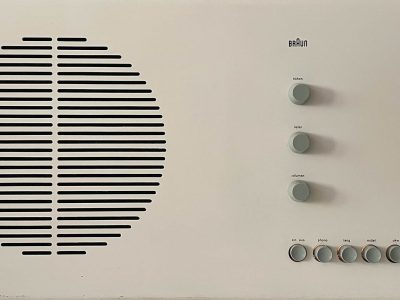
Interview Naoto Fukasawa
The Japanese designer has a long relationship with Dieter Rams and his work. As a student in the 1980s, he was first confronted with Braun products: as examples of good design. Here, Fukasawa talks about subtle details and shades of gray — as well as his special, personal connection to Dieter Rams.
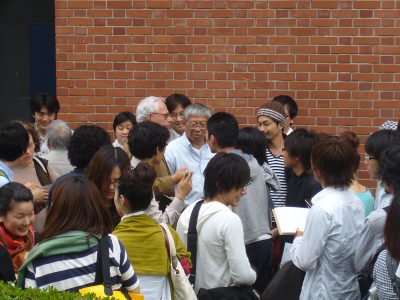
Braun Design in Asia
